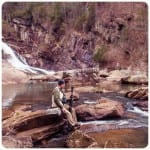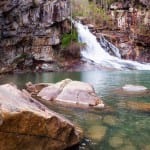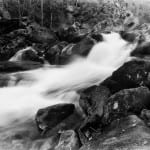My buddy Lou Hablas and I headed to northeast Georgia last week to hike into Tallulah Gorge and make a few pictures. Tallulah Gorge is a good place to shoot in the winter. There are spots where the foliage would be prettier in the Spring or Fall, but the Gorge floor is mostly rocks and river. You can visit the observation platforms in the Gorge via stairs and bridges from the State Park visitor center, but Lou and I got our (free) permits so we could go beyond the rails and explore the Gorge floor.
I’ll tell you that the hike down the Gorge from the suspension bridge to Bridal Veil Falls is fairly strenuous. The ranger at the interpretive center described a simple “cross the river- hike down- cross the river- and hike back” trip, but there was a bit more to it than that! Our first river crossing was fairly easy once we decided where we would jump across. The hike itself is not bad, but most of the trip could be described as a “scramble” over rocks and boulders. Lou and I enjoyed the hike and especially the unique shooting opportunities that such a hike presents.
The end of the hike had us crossing the river through thigh-deep (COLD) water at the top of Bridal Veil Falls. We had assumed that “crossing the river” meant crossing on rocks at least 🙂 We took the Slick Rock trail to the top of the Gorge. This “trail” is more of a climb than a hike. It is a bit more of an undertaking than the stairs and boardwalks on the rest of the park trails. All-in-all we worked our butts off and had a lot of fun!
I had a couple of camera bodies with me, including my infrared Olympus E-P3 and my new Panasonic GH3. It’s really nice to be able to use all of the great Micro 4/3 cameras and lenses interchangably. My go-to lenses for landscapes are currently the Olympus 12mm f2 and the Olympus 60mm f2.8 macro. I had the chance to borrow Lou’s Panasonic 12-35mm f2.8 zoom lens and shoot it side by side with the Oly 12mm. I was surprised to find that there is virtually no difference between two images. The Panasonic 12-35mm is a really versatile lens, and it is as sharp as my favorite 12mm Olympus lens.
After talking with Will Crockett and the rest of the gang from discovermirrorless.com at Imaging USA, I got really excited about hybrid photography. Hybrid photography is basically a way to think about still photos and video. Rather than still photos OR video, hybrid photography is a combination of the two so that the two mediums support each other. I am excited about the application of hybrid photography for travel and landscape photography, and I will be teaching these techniques at my workshops from now on.
The video at the beginning of this post is an example of a hybrid eScape. The video clips show the motion of the water in a way that a still photo can’t, and they help tell the story along with the still images. I shot the stills and video with my Panasonic GH3. The video capabilities of hybrid cameras like the GH3 and the Olympus OM-D E-M5 make shooting for these hybrid projects SO easy! The difference in shooting a still frame and shooting video is literally the difference in pushing one button or the other. Of course shooting video can get much more involved if you are so inclined, but it doesn’t have to be like learning a second language. I’m learning that video can be a fun addition to my “regular” photography without a ton of extra work.





0 Comments